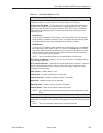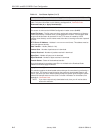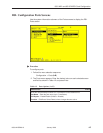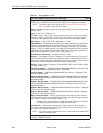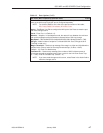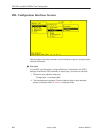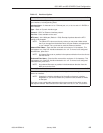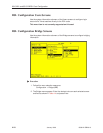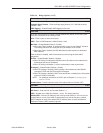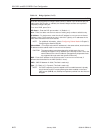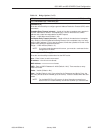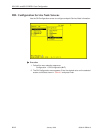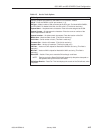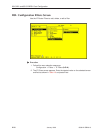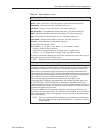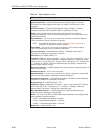
8310 MVL and 8510 RADSL Card Configuration
4-11
8000-A2-GB26-10
January 1999
Table 4-4. Bridge Options (1 of 3)
General (General Bridge Parameters) A-E-A
Gives the user the ability to configure general bridge parameters.
Complete Entry Timeout – Enter the bridge aging timeout (10–1,000,000 seconds)
(Default = 300).
VNID Tagging – Enable/Disable VNID tagging on the card.
Card VNID A-E-B
Gives the user the ability to configure Virtual Network IDs (VNIDs) for the entire card.
There are a maximum of 16 entries per card.
Item – Enter 0 (zero) to add a new record.
VNID – Enter a VNID between 2–4094 (Default = Null).
Mux Fwd – Enable/Disable (Default = Enable).
H When Mux Fwd is enabled, all upstream traffic is sent out the 10BaseT interface.
Forwarding restrictions are set by the other parameters on the screen.
H When Mux Fwd is disabled, the DSLAM forwards traffic based on a destination
MAC address.
Either enabled or disabled, traffic is forwarded on ports having the same VNID
designation.
IP Filter – Enable/Disable (Default = Disable).
H When IP filtering is enabled,the DSLAM looks at IP traffic from the subscriber to
authenticate the source IP address.
H When IP filtering is disabled, no source authentication check is performed.
IP Scoping – Enable/Disable (Default = Enable).
H When IP Scoping is enabled, DHCP scoping is also enabled and the DSLAM
intercepts IP ARP and DHCP transaction messages.
H When IP Scoping is disabled, DHCP client entries are not added to the Client table
and non-IP traffic is forwarded.
NOTE: For additional information on DHCP, refer to Chapter 3,
Configuring the
Hotwire DSLAM
.
Domain Name – Enter the domain name of the Internet Service Provider (ISP).
Port VNID A-E-C
Gives the user the ability to configure one VNID association on an individual port.
DSL Port # – Enter the DSL port number (Default = 1).
VNID – Number of the VNID port (Default = none). This field is read-only.
Default NHR – Enter the IP address of the next hop router (NHR) in
nnn.nnn.nnn.nnn
format (Default = none). If the NHR IP address does not exist for that port, a default
NHR IP address is used. If the default NHR IP address does not exist, the Address
Resolution Protocol (ARP) request is ignored.



